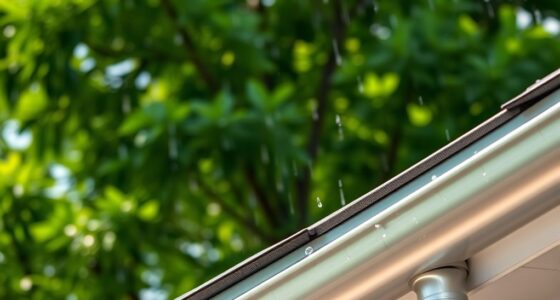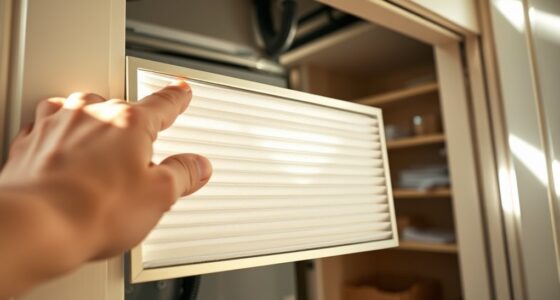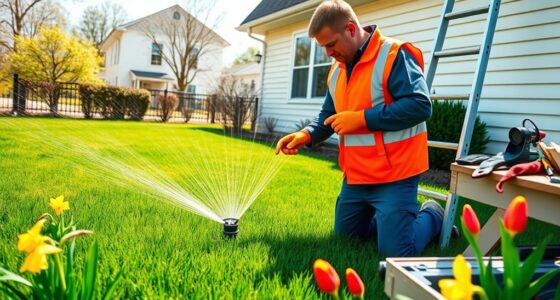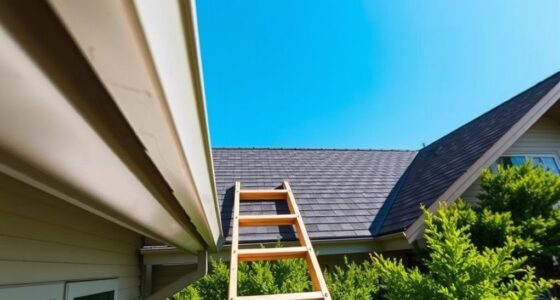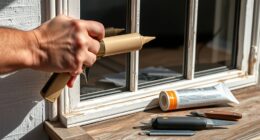To find hidden water leaks, look for signs like damp spots, unexplained high water bills, or mold growth in concealed areas. Use tools like thermal imaging, electronic listening devices, and pressure gauges to accurately locate leaks without damaging your home. Acting early prevents costly repairs and water damage. If you want to learn more about how to detect and fix these elusive leaks, there’s valuable information waiting for you below.
Key Takeaways
- Use electronic listening devices and thermal imaging to detect hidden leaks without invasive methods.
- Look for signs like unexplained increases in water bills, damp spots, mold, or musty odors.
- Check inaccessible areas such as behind walls, under slabs, or in ceilings for water damage or mold growth.
- Insulate pipes properly to prevent freezing and reduce the risk of leaks in vulnerable areas.
- Regularly monitor water pressure and utilize leak detection tools to identify leaks early and prevent extensive damage.

Hidden water leaks can sneak into your home, causing damage and increasing your water bills before you even notice them. The key to preventing costly repairs is catching these leaks early. Start by inspecting your home for signs like damp spots on walls, ceilings, or floors, as well as unexplained increases in your water bill. Sometimes, the leak isn’t obvious, especially if it’s behind walls or under the floor. That’s when professional leak detection tools become invaluable. These devices can pinpoint the exact location of a hidden leak without invasive procedures, saving you time and money.
One of the simplest ways to prevent leaks in the first place is by properly insulating your pipes. Pipe insulation not only helps maintain steady water temperatures but also protects pipes from freezing and bursting during cold weather. When pipes freeze and crack, it often leads to significant leaks that are hard to detect immediately. Installing quality pipe insulation around vulnerable pipes, especially in unheated areas like basements, attics, or garages, can considerably reduce the risk of leaks. Furthermore, insulated pipes are less prone to expanding and contracting, which over time can cause cracks and leaks to develop. Additionally, using water-efficient fixtures can help reduce strain on your plumbing system and minimize the risk of leaks caused by overuse or pressure issues.
If you suspect a leak but can’t see any obvious signs, it’s time to use leak detection tools. These tools come in various forms, from electronic listening devices that detect the sound of running water to pressure gauges that monitor fluctuations in your plumbing system. Some advanced leak detection devices use thermal imaging to identify temperature differences caused by escaping water. When you use these tools correctly, you can locate hidden leaks behind walls or under the slab without tearing into your home’s structure. This proactive approach helps you address leaks early, preventing water damage and saving money on repairs.
Frequently Asked Questions
How Can I Detect Leaks Behind Walls?
You can detect leaks behind walls by checking your water meter first—turn off all water and note the reading; if it moves later, there’s a leak. Look for signs like damp spots or mold. Inspect pipe insulation for damage or dampness, which indicates a leak. You might also use a moisture meter or listen for hissing sounds. These steps help identify hidden leaks before they cause major damage.
Are There DIY Methods to Locate Hidden Leaks?
If you suspect a hidden leak, you can try DIY methods like using a moisture meter to detect damp spots or dye testing to trace water flow. For example, imagine discovering a hidden leak behind your wall, causing mold. You could use a moisture meter on suspect areas or inject dye into your pipes to see if it appears elsewhere, helping you identify leaks without expensive tools or professional help.
When Should I Call a Professional Plumber?
You should call a professional plumber when DIY methods like checking water pressure and inspecting pipe insulation don’t reveal the source of a leak or if you notice persistent dampness or mold. If your water pressure drops suddenly or your bills spike unexpectedly, it’s time to get expert help. A plumber can accurately locate hidden leaks and fix them efficiently, saving you from costly water damage down the line.
What Tools Are Best for Leak Detection?
Think of yourself as a detective unraveling a mystery—your tools are key. For DIY inspection, leak detection tools like moisture meters, acoustic listening devices, and thermal cameras are your allies. These gadgets help reveal hidden leaks behind walls or beneath floors. Using them, you can pinpoint the problem accurately, saving time and money. Mastering these tools makes you a water leak detective, ensuring your home stays dry and leak-free.
How Can I Prevent Future Hidden Leaks?
You can prevent future hidden leaks by performing regular preventative maintenance on your plumbing system. Check for signs of wear or corrosion and repair issues promptly. Insulate your pipes with high-quality pipe insulation to protect against freezing temperatures, which can cause pipes to burst and leak. Also, consider installing a water leak detector to catch problems early. These steps help keep your plumbing in good condition and avoid costly water damage.
Conclusion
So, you’ve bravely hunted down those sneaky leaks, wielding your trusty tools like a plumbing superhero. Now, with the mystery solved, you can sit back and enjoy your leak-free life—until the next one decides to hide in plain sight. Remember, neglecting these tiny water villains could turn your home into an indoor pond. Stay vigilant, keep those pipes in check, and maybe invest in a waterproof cape—just in case.


